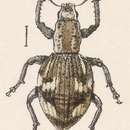en
names in breadcrumbs


Isodacrys is a genus of broad-nosed weevils in the beetle family Curculionidae. There are 20 described species in Isodacrys,[1][2][3][4][5] ranging from the southern United States of America to Honduras.[5]
Isodacrys species are distributed from south of the United States of America to Honduras, mainly across Mexican and Central American mountain ranges of ~1500–3100 meters above sea level; some species also occur in lowlands.[5] The adults of Isodacrys have been found in Quercus, Pinus and in other plants of different families as Asteraceae, Fabaceae, Rhamnaceae, Cucurbitaceae, Betulaceae, Malvaceae, and Solanaceae. Some adults have been collected from leaf litter and under rocks.[6][5] Immature stages remain unknown.[5]
These 13 species belong to the genus Isodacrys:
Data sources: i = ITIS,[1] c = Catalogue of Life,[2] g = GBIF,[3] b = Bugguide.net[4]
Isodacrys is a genus of broad-nosed weevils in the beetle family Curculionidae. There are 20 described species in Isodacrys, ranging from the southern United States of America to Honduras.